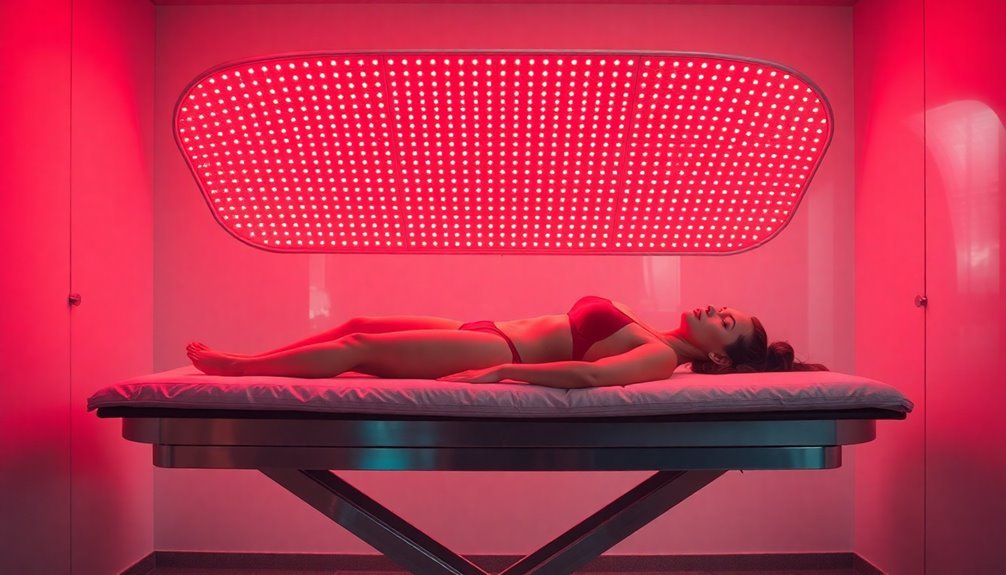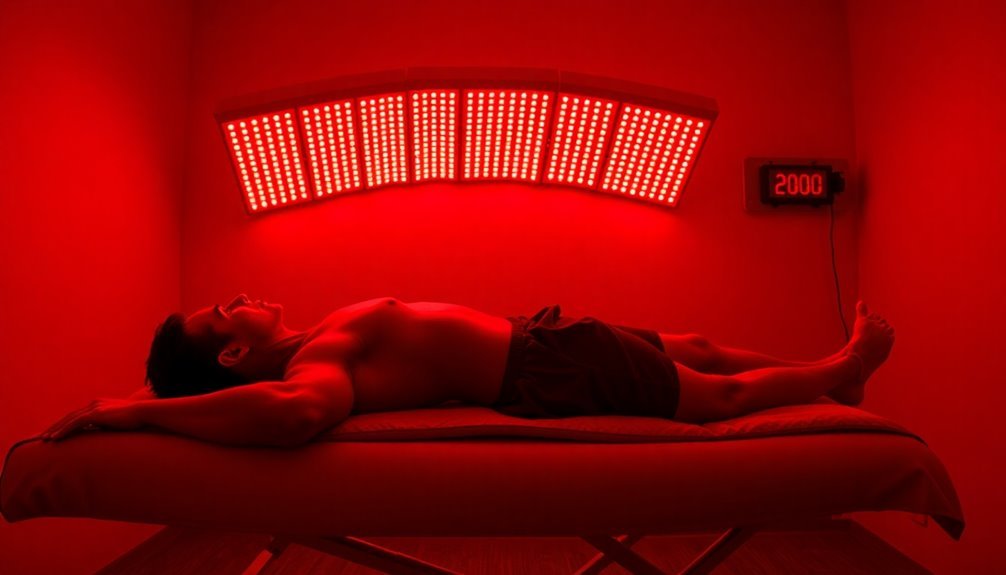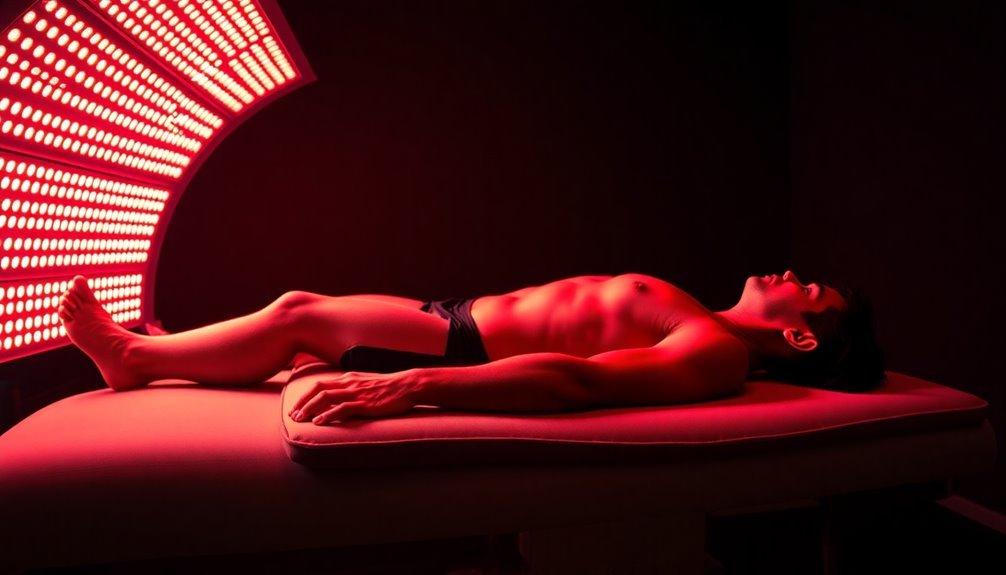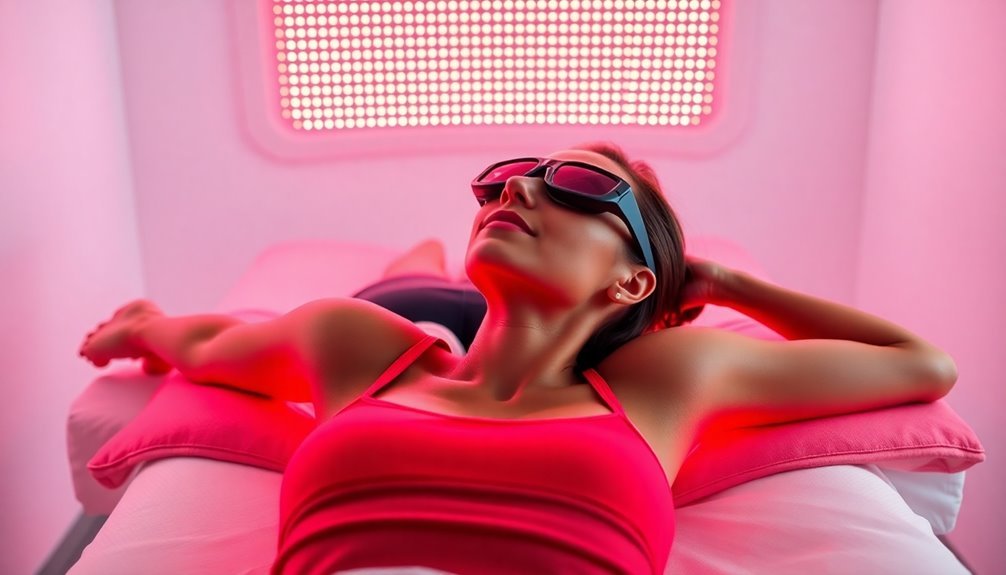During post-workout LED therapy, your body experiences powerful cellular changes that speed up recovery. When specific wavelengths of light hit your muscles, they activate your mitochondria – your cells' power plants – boosting ATP production and energizing tissue repair. Your blood vessels dilate, increasing circulation and delivering more oxygen and nutrients to fatigued areas while flushing out waste products. The therapy reduces inflammation markers that cause soreness and swelling, while also fighting exercise-induced oxidative stress. Understanding the ideal timing and protocols for LED treatments can maximize these recovery-enhancing benefits for your fitness routine.
The Science Behind LED Recovery

The light therapy improves how your cells communicate with each other, leading to better-coordinated muscle function and faster healing.
Through a process called photobiomodulation (PBM), your body accelerates cell regeneration and repair. Specific wavelengths of red light penetrate your tissues to stimulate mitochondria and boost cellular energy production.
The therapy enhances blood circulation, ensuring your muscles receive more oxygen and nutrients.
This combined action not only speeds up your recovery but also helps prepare your muscles for future workouts by strengthening their cellular infrastructure and reducing inflammation.
Cellular Changes During Light Sessions
During LED light therapy sessions, your cells undergo remarkable transformations at the molecular level. Your mitochondria, the powerhouses of your cells, become activated when exposed to specific wavelengths of light, triggering a cascade of biological responses that enhance your post-workout recovery.
When the light penetrates your tissue, it interacts with photoreceptors, particularly cytochrome C oxidase, which kicks your cellular energy production into high gear. This boost in ATP energizes your cells and promotes faster healing while reducing inflammation in your worked muscles. The light wavelengths between 390 and 1,200 nanometers provide optimal tissue penetration for therapeutic benefits.
- Your blood circulation improves as vessels dilate, delivering more oxygen and nutrients to recovering tissues
- Your cells produce more antioxidants, fighting exercise-induced oxidative stress
- Your mitochondria increase ATP production, powering cellular repair processes
- Your immune system gets enhanced through increased cellular activity
The photobiomodulation process activates multiple cellular signaling pathways, leading to improved tissue repair and reduced muscle soreness.
Your cells' interaction with the light triggers the release of anti-inflammatory molecules while stimulating collagen production, which benefits both muscle recovery and skin health.
This cellular activity continues even after your therapy session ends, supporting your body's natural healing processes.
Timing Your Post-Exercise Treatment

Ideal timing of LED therapy sessions can substantially impact your post-workout recovery results. You'll want to schedule your sessions strategically, with different approaches for various workout types. For endurance training, you'll need 5-10 minutes both before and after your session, while strength training benefits most from pre-workout treatment. These treatments stimulate your cells to produce more efficient ATP, helping you recover faster from intense exercise.
| Workout Type | Recommended Timing |
|---|---|
| Endurance/Cardio | 5-10 mins before & after |
| Strength Training | 5-10 mins before only |
| General Fitness | 10-15 mins before |
| Recovery Focus | 10-20 mins after |
For best results, you'll need to adjust the treatment duration based on the muscle groups you're targeting. Smaller muscles require 20-60 joules, while larger muscle groups need 60-300 joules. You can maximize benefits by combining pre and post-workout treatments, but don't try to use LED therapy during your actual workout, as this isn't practical or effective.
Remember to maintain consistency with your therapy sessions, aiming for at least 15-minute treatments several times per week. When paired with proper nutrition and adequate rest, this timing strategy will enhance your recovery and improve overall athletic performance.
Muscle Recovery Enhancement Process
Through advanced photobiomodulation mechanisms, LED therapy accelerates your muscle recovery by stimulating cellular repair at multiple levels. When you expose your muscles to specific wavelengths of red light, your mitochondria become more active, boosting ATP production – your cells' essential energy source.
This enhanced cellular activity triggers a cascade of healing responses throughout your muscle tissue. Originally developed by NASA scientists, this therapy has revolutionized how we approach muscle recovery.
During your LED therapy session, you'll benefit from four key recovery-enhancing processes:
- Increased blood flow delivers more oxygen and nutrients to your fatigued muscles, speeding up natural recovery
- Reduced inflammation markers help minimize post-workout soreness and swelling
- Accelerated tissue repair through stimulated cellular regeneration and muscle stem cell activation
- Decreased oxidative stress levels, which typically slow down recovery
Your muscle function improves as these processes work together, helping you bounce back faster from intense workouts.
The therapy's effectiveness is backed by clinical studies showing significant reductions in recovery time and muscle soreness. For ideal results, you'll want to maintain consistent sessions of at least 15 minutes, using devices that emit wavelengths between 640-950 nm, targeting your specific areas of muscle fatigue.
Optimal Treatment Protocols

A successful LED therapy protocol combines precise timing, wavelength selection, and application methods to maximize your recovery benefits. You'll want to focus on wavelengths between 640-950 nm, with specific attention to red light (630-680 nm) and near-infrared light (800-850 nm) for deeper tissue penetration.
Your device should deliver 10-35 mW per LED without becoming hot to touch. Studies show that these wavelengths help stimulate ATP production in muscle cells.
Time your sessions strategically: use 5-10 minutes before strength workouts and 15-20 minutes post-exercise. You'll get the best results by maintaining 3-5 sessions weekly, positioning the device 6 inches from your skin.
For targeted treatment, apply 20-60 joules to smaller muscles and 60-300 joules to larger muscle groups.
You'll need to adjust your protocol based on your workout intensity and recovery needs. If you're treating your whole body, focus on the most worked muscle groups first.
Don't forget to stay well-hydrated, as it enhances the therapy's effectiveness. Combine your LED sessions with proper nutrition and stretching for ideal results.
Remember that consistency is key – regular sessions will deliver better long-term benefits than sporadic treatments.
Frequently Asked Questions
Can LED Therapy Sessions Help With Chronic Joint Pain Conditions?
Yes, LED therapy can effectively help your chronic joint pain. It'll reduce inflammation, stimulate healing, and improve mobility in conditions like arthritis and fibromyalgia through its non-invasive, light-based treatment approach.
Does Skin Color or Thickness Affect the Effectiveness of LED Therapy?
No, your skin color and thickness won't affect LED therapy's effectiveness. The wavelengths, especially red light, penetrate effectively across all skin types, and studies show consistent results regardless of skin characteristics.
Should You Wear Sunscreen During LED Therapy Sessions?
You don't need sunscreen during LED therapy sessions, as it could interfere with the treatment's effectiveness. However, you'll want to apply sunscreen after your session to protect your newly treated skin when going outside.
Can LED Therapy Interfere With Performance-Enhancing Supplements or Medications?
While LED therapy is generally safe, you'll need to consult your doctor if you're taking photosensitive medications. There's no direct evidence of interference with performance supplements, but professional guidance is always recommended.
Are There Different Colored LED Lights for Different Types of Injuries?
Yes, you'll find different LED colors target specific injuries: blue light treats skin conditions and wounds, red light helps muscle recovery and pain, while infrared penetrates deeper for joint and tissue healing.
In Summary
You'll maximize LED therapy's benefits by timing your sessions within 2 hours after training. Whether you're using red, infrared, or combination light panels, consistent 10-20 minute treatments will help reduce inflammation, speed muscle repair, and boost cellular energy production. Don't skip your cool-down routine – LED therapy works best when combined with proper hydration, stretching, and recovery nutrition for ideal results.





Leave a Reply